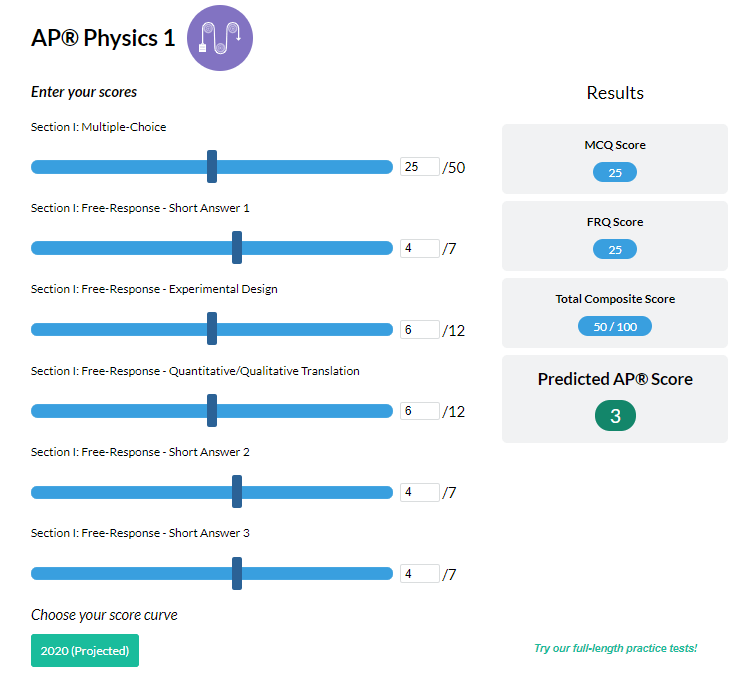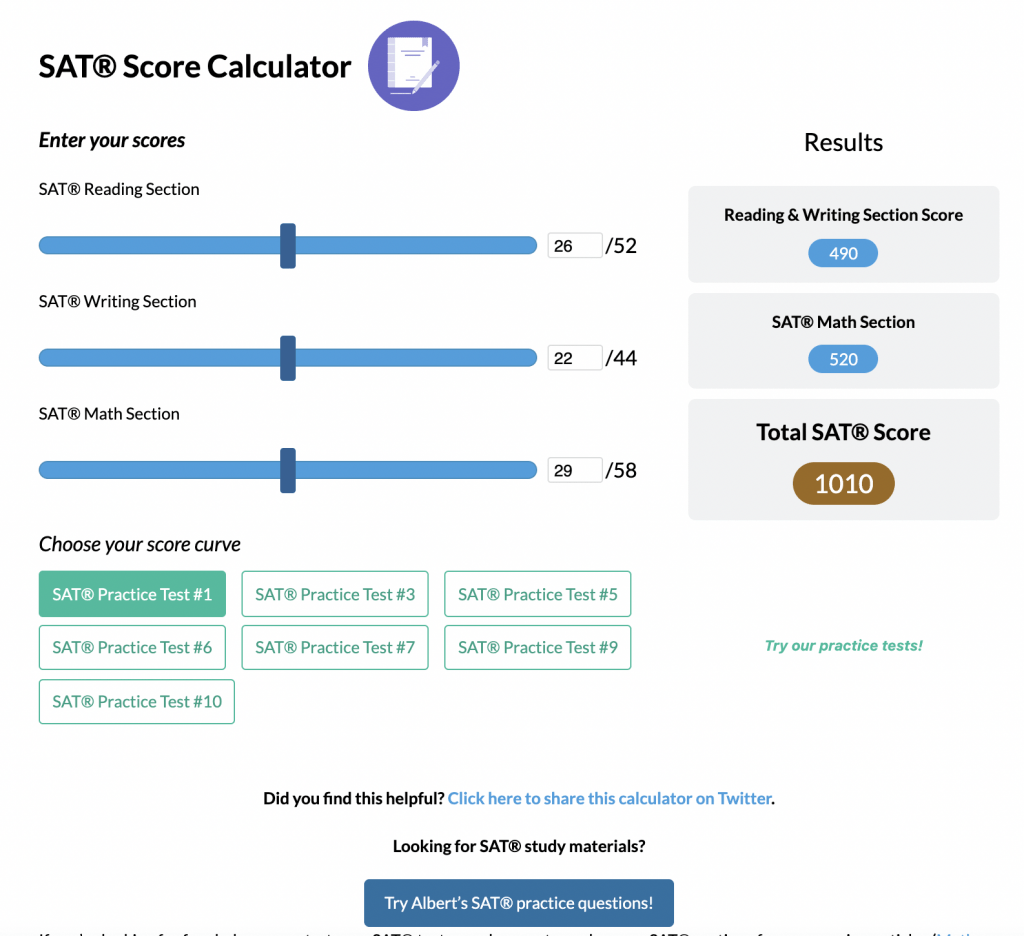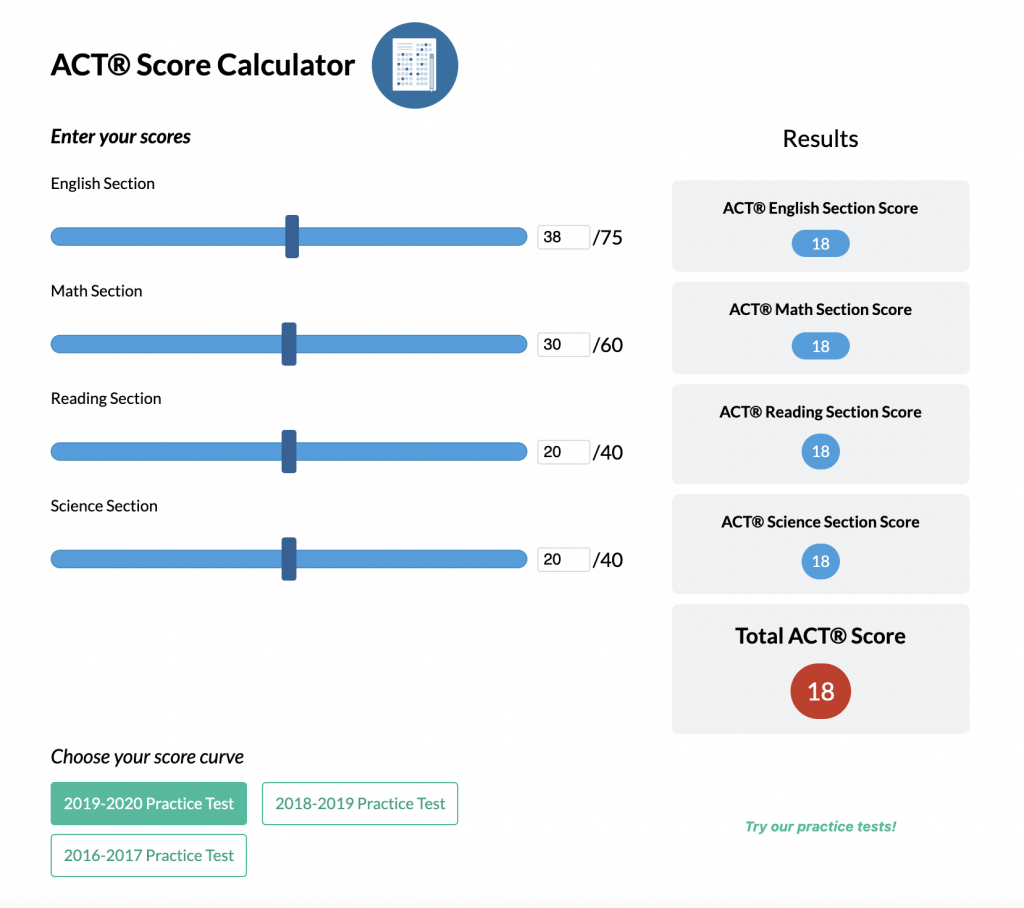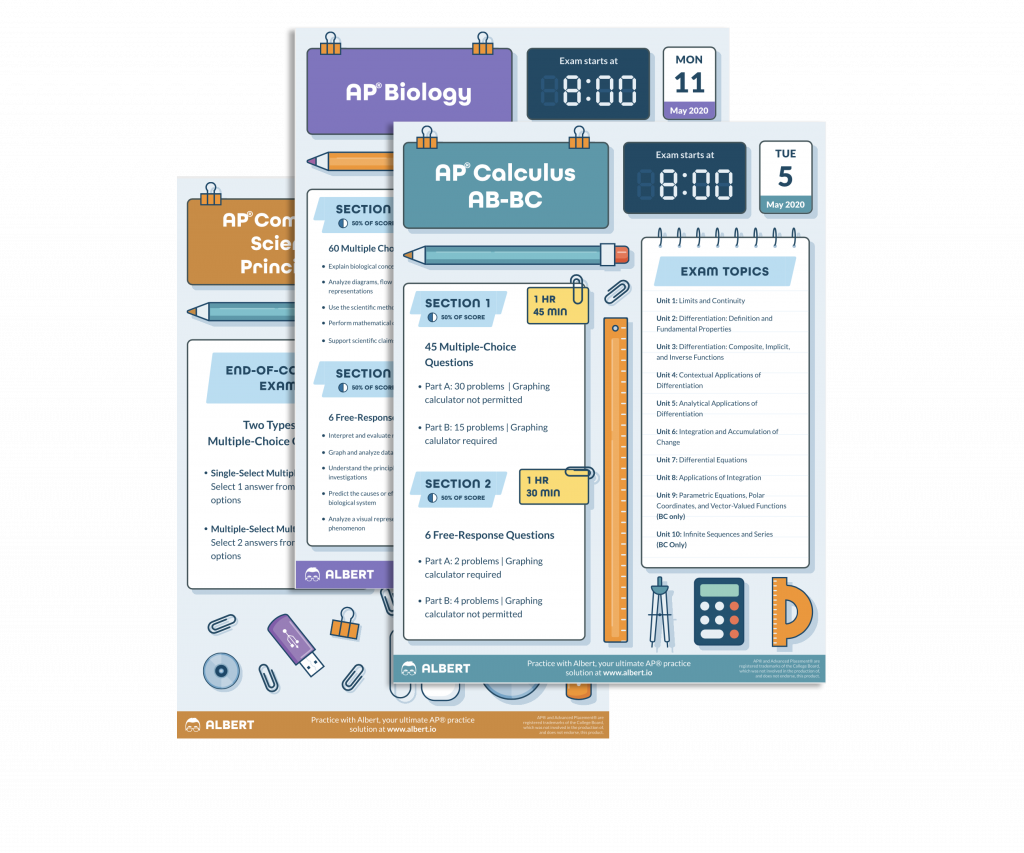At first glance, the ACT® Math section seems overwhelming. It will test you on formulas and theorems from pre-algebra, algebra and geometry, concepts that you might not have practiced since freshman year. Luckily, this ACT® Math guide will boil it down to the nine most important concepts you need to know to ace this section.
The new ACT® Math section focuses less on raw calculations and more on data analysis, which means you’ll be asked to look at a set of data (figures, lines, algebraic expressions, etc.) and figure out what you need to do to get the answer. That’s why this ACT® study guide doesn’t just give you a list of formulas – what good is a formula if you don’t understand how it works? This guide will explain the fundamentals of each concept, define the important terms, and walk you through the most difficult formulas step by step.
1. Exponents and Roots

An exponent is just a fancy-looking shortcut. When you want to multiply a number by itself several times, you could do each calculation one at a time. For example, let’s look at lucky number 13, and multiply it by itself 7 times.
13∗13∗13∗13∗13∗13∗13=62,748,517
That works, but it takes time, and you only have 60 minutes for this section. You don’t want to waste time punching the same number in your calculator when there’s a much easier way to do the same equation:
137=62,748,517
Now let’s break down what we just did.
137
Exponent: the number of times a number is multiplied by itself.
Base: a number that will be multiplied by itself.
Power: a base and an exponent.
In the example above, the exponent is 7 and the base is 13.
What if you want to go one step further and deal with more than one exponent at a time? Now you’re talking!
To multiply powers with the same base, add the exponents.
x2∗x9=x11
To divide powers with the same base, subtract the exponents.
x5/x2=x3
What if you want to raise an entire power to an exponent? Can that be done?
Of course. Just multiply the power’s current exponent by the exponent you want to raise the power to.
(x6)3=x18
Now let’s look at the opposite of powers, which are roots.
Square root: a number which, when multiplied by itself, equals a certain number.
Radical sign: symbol designating square root, cube root, etc.
For example, if you want to take the square root of 144, you’re trying to figure out which number multiplied by itself equals 144.
122=144
Therefore:
144=12
12 is the square root of 144.
If you’re taking the square root, then the radical sign won’t be labeled. However, for all other roots, such as the cubed root, the radical sign will be labeled with a number n. You will take the nth root of the number under the radical sign.
4625=x
54=625
x=5
Radicand: the number or expression under a radical sign.
For example, when we looked at 144
144 is under the radical sign, so 144 is the radicand.
To add or subtract square roots, assuming the radicands are the same, just add or subtract the number in front of the radical. Leave the radicand the same.
64+34=94
102−32=72
To multiply two square roots, multiply the radicands and take the square root of the product.
6∗3=6∗3=18
To divide a square root, divide the numbers under the radical and take the square root of the quotient.
183=18/3=6
To simplify a square root, factor out any perfect squares in the radicand.
32=16∗2=42∗2=42
2. Logs
A completed power has three parts: the base, the exponent, and the answer.
If you have a base and an exponent, you can compute the answer y.
22=y
y=4
If you have the answer and the exponent, then you can use a radical to compute the base b.
4=b2
4=b
b=2
What if you have the answer and the base, but not the exponent x?
2x=4
x=?
Then you need to use a log. Don’t worry about doing logs by hand – if you set up your log correctly, then your calculator will compute the answer.
Let’s look at how to set up a log step by step.
In a power, y is the answer, b is the base and x is the exponent.
bx=y
To find x, set up a log like this:
x=logby
For example:
2x=16
log216=x
Now, how do you plug that into your calculator? Your calculator’s “log” function is set up for logs with a base of 10, but chances are you’ll be working with a different base. Therefore, you’ll need to use the change of base formula.
logby=logylogb=lnylnb
On your calculator, you can use either the “log” or the “ln” function when using the change of base formula. Just plug in your b and y.
log216=log16log2=ln16ln2
log216=4
x=4
Voila!
3. Algebraic Expressions – Order of Operations
PERMDAS
The building block of algebra is the order of operations, or PERMDAS. This is the order that you will always solve an equation in, and remembering PERMDAS will help you when you encounter convoluted multi-step equations.
Parentheses
Exponents/Radicals
Multiplication/Division
Addition/Subtraction
Let’s look at a complicated example. The ACT® exam will most likely not give you anything that looks quite like this, but if you can master this then you’ll have PERMDAS down pat.
(72+9−2+216)∗8−2−122
First, evaluate the parentheses. You’ll be working with the parentheses first.
(72+9−2+216)
Within the parentheses, evaluate the exponents and radicals first:
(49+9−2+2∗4)
Then multiplication and division:
(49+9−2+8)
Then addition and subtraction:
49+9−2+8=64
Now that we have that number, we move to the rest of the equation:
64∗8−2−122
Remember, exponents first:
64∗8−2−144
Then multiplication:
512−2−144
Finally, addition and subtraction:
512−2−144=366
There you have it!
4. Angles
When two lines come together, they form an angle.
Keep this list of vocabulary in mind, and then we’ll look at examples step by step over the next several sections.

Angle: the space between two intersecting lines.
Acute Angle: an angle measuring less than 90 degrees.
Obtuse Angle: an angle measuring more than 90 degrees but less than 180 degrees.
Right Angle: an angle measuring 90 degrees.
Reflex Angle: an angle measuring greater than 180 degrees but less than 360 degrees.
Intersecting Lines: two lines that cross that a vertex.
Vertex: the point where two lines intersect.

Supplementary Angles: two angles that add up to exactly 180 degrees.
Complementary Angles: two angles that add up to 90 degrees.

Adjacent Angles: two angles that share a side and a vertex.

Vertical Angles: two angles that are opposite each other when lines intersect.
Parallel Lines: lines with the same slope that will never touch.
Perpendicular Liens: lines that intersect at a right angle.
When two lines intersect, they create four angles, adding up to a total of 360 degrees.
The adjacent angles are supplementary. To solve for an unknown angle, subtract its adjacent angle from 180.

Let’s look at the angle above. Let’s start by solving for c if a = 130.
C and A are adjacent and supplementary, adding up to 180 degrees.
180−130=c
c=50
Vertical angles are equal. You could also solve for an unknown angle by finding its vertical angle.
Now that we know c, let’s solve for d. C and D are vertical angles.
c=d
c=50
50=d
5. Area
If you’ve ever tried to figure out how much wrapping paper you need to wrap a gift, or how much cake batter you’ll need to fill a pan, then you’ve worked with area.
Area: the amount of space inside of a shape.
To find the area, you’ll need different formulas for different shapes.
Let’s define some variables that will stay the same throughout the following equations.
l = length of the shape
w = width of the shape
r = radius of the shape
b = base
h = height

The area of a square:
l2
The area of a rectangle:
l∗w
The area of a parallelogram:
l∗h
The area of a triangle:
21b∗h
The area of a circle:
πr2
We’ll revisit triangles in the trigonometry section.
More About Circles
In addition to taking the area, you may have to work with the sector and the arc of a circle as well.
Sector: a portion of a circle.
Arc: a portion of a circle’s circumference.

Area of a sector, if the sector angle is s and the radius is r:
(s/360∘)∗(πr2)
For example, if the sector angle above is 95 and the radius is 6:
Area=(95/360)∗(π(62))
Area=29.8313
Length of an arc if the arc angle is s and the radius is r:
(s/360)∗(2πr)
For example, if the arc angle is 95 and the radius is 6:
Length=(95/360)∗(2π(6))
Length=9.9438
Circumference of a circle:
2πr
6. Volume and Surface Area

Volume: the amount of space inside a three-dimension object.
Sometimes, you’ll be given three-dimensional figures and told to figure out the volume. It may seem tricky at first, but a few key formulas will make calculating the volume a breeze.
l = length of the shape
h = height of the shape
w = width of the shape
r = radius of the shape
Volume of a cylinder:
πr2∗h
Volume of a cone:
31πr2∗h
Volume of a sphere:
34πr3
Volume of a cube:
l3
Rectangular prism:
l∗w∗h
Surface Area: sum of the areas of each side of a three-dimensional object.

Surface area of a cylinder:
(2πr2)+(2πrh)
Surface area of a cone:
(πr2)+(πr)∗(h2+r2)
Surface area of a sphere:
4πr2
Surface area of a cube:
6∗a2
Surface area of a rectangular prism:
2lw+2wh+2lh
7. Coordinate Geometry
What in the world is coordinate geometry?
Well, geometry is the study of shapes. Therefore, coordinate geometry is the study of lines and shapes that just happen to lie on a coordinate plane.
Based on the line’s points (called coordinates), you’ll have to calculate the slope of the line and the distance between two points.
Slope
Slope: the steepness of a line.
To find the slope, use the slope formula:
The thing to remember about slope is runrise
The rise is the change in the y-axis from the first point to the second point, and the run is the change in the x-axis from the first point to the second point.
m=(x2−x1)(y2−y1)
Y2 is the y-coordinate of the second point.
Y1 is the y-coordinate of the first point.
X2 is the x-coordinate of the second point.
X1 is the x-coordinate of the first point.
Let’s look at an example. Say that you want to find the slope m between (-4, -7) and (12, 1).
Y2=1
Y1=−7
X2=12
X1=−4

Distance
To find the distance between two points, use the distance formula:
distance = (x2−x1)2+(y2−y1)2
Let’s look at an example. Say that you want to find the distance d between (1, -4 ) and (-4, 2).
X2=−4
X1=1
Y2=2
Y1=−4
d=(x2−x1)2+(y2−y1)2
d=(−4−1)2+(2−(−4)2
d=(−5)2+62
d=61
Therefore, the distance is:
61
Equation of a Line
To find the equation of a line, use slope-intercept form.
Y-intercept: the value of y when x = 0.
X-intercept: the value of x when y = 0.
If m is the slope and b is the y-intercept, the equation of a line is y=mx+b
Let’s look at an example. What is the equation of the line if the slope is 2 and the y-intercept is (0, 3)?

The equation is y=2x+3
8. Trigonometry
Trigonometry is just a fancy word for the study of triangles and their angles.
Basics of Triangles
Triangle: a polygon with three points and three sides. Its interior angles add up to 180 degrees. Its exterior angles add up to 360 degrees.
Scalene Triangle: a triangle with three unequal sides.
Isosceles Triangle: a triangle with two equal sides.
Right Triangle: a triangle containing one right angle.
Similar Triangle: triangles whose corresponding angles are congruent, or equal.
If two triangles are similar, that means that they are proportional. You can determine the value of one triangle’s side by setting up a proportion with the corresponding side of a similar triangle.

In the example above, triangle 1 and triangle 2 are similar. If we want to find x, then we need to set up a proportion.
x10=126
If you solve for x, then: x=20
To find the length of the hypotenuse (the longest side) of a triangle, use the Pythagorean theorem. If a and b are the short legs of the triangle and c is the hypotenuse, then:
a2+b2=c2

If a = 3 and b = 4, then our equation will look like this:
32+42=c2
9+16=c2
25=c2
c=5
SOHCAHTOA
The basic rule of trigonometry is SOHCAHTOA. While that may sound like a foreign word, it’s really an acronym that will help you take the sine, cosine and tangent of acute triangles.
Sine, cosine and tangent are the ratios of sides in a right triangle. That means that once you know the length of two or more sides of the right angle, you just need simple division to figure out the rest. Let’s break down SOHCAHTOA to help you remember.

Opposite: the side across from the angle whose sine, cosine or tangent you are finding.
Adjacent: the non-hypotenuse side next to the angle whose sine, cosine or tangent you are finding.
Hypotenuse: the longest side of a right triangle.
SOH: sine=hypotenuseopposite
CAH: cosine=hypotenuseadjacent
TOA: tangent=adjacentopposite

Now that you know how to take sine, cosine and tangent, let’s look at their reciprocals: cotangent, secant and cosecant. The ACT® Math section may ask you to take the reciprocal.
cosecant=sine1=oppositehypotenuse
secant=cosine1=adjacenthypotenuse
cotangent=tangent1=oppositeadjacent
9. Probability
If you’ve ever rolled a die or tossed a coin, you’ve dealt with probability. Probability is the study of how likely an event will occur. For example, your chances of rolling a 2 when you throw a die are 1/6, because there are six sides on the die. Or when your weatherman says that there’s a 90% chance of rain, then you’d better bring an umbrella.
If you study these probability basics, then your probability of doing well on this part of the exam is very high!
Favorable outcome: an event that you want to occur.
Total possible outcomes: the total number of events that could occur.
Probability that an event will occur:
Number Of Total Possible Outcomes Number Of Favorable Outcomes
For example, let’s go back to the die. What are the chances that you’ll roll a 1 or a 2?
In this case, there are 2 favorable outcomes and 6 total possible outcomes.
62=31
The probability is 31
Probability that an event will not occur:
1−Number Of Total Possible Outcomes Number Of Favorable Outcomes
What are the chances that you won’t roll a 5? Rolling a 5 is the favorable outcome.
1−61=65
Your chances are 65.
Probability that two unrelated events will occur:
(Probability Of Event 1)∗(Probability Of Event 2)
What is the probability that you will roll a 1 or a 2, and then you’ll roll a number that’s not a 5?
(31)∗(65)=185
The probability is 185
Conclusion
You’ve just covered the nine most important concepts for the ACT® Math section. You are well on your way to an ACT® score of 36!
Looking for ACT® practice?
You can find thousands of practice questions on Albert.io. Albert.io lets you customize your learning experience to target practice where you need the most help. We’ll give you challenging practice questions to help you achieve mastery of the ACT®.
Start practicing here.
Are you a teacher or administrator interested in boosting ACT® student outcomes?
Learn more about our school licenses here.








